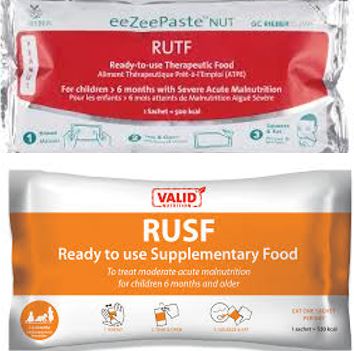
Table of Contents
Background:
- RUTF stands for Ready-to-Use Therapeutic Food while RUSF stands for Ready-to-Use Supplementary Food.
- A number of enterprises are dedicated on making RUTF and RUSF products that fulfill with nutritional necessities.
- RUTF and RUSF are made from fixings that are crisp, of good quality, free from outside materials and substances perilous to wellbeing, that consent to Codex Alimentarius or significant guidelines.
- Despite standard factory manufacturing, local production of RUTF paste at present is under way in numerous nations comprising Congo, Ethiopia, Malawi, Niger, Bangladesh etc.
Similarities between RUTF and RUSF:
- RUTF and RUSF are both given to treat/manage acute malnutrition in children of 6-59 months of age.
- RUTF and RUSF are fortified lipid-based paste.
- These products are NOT a breast milk replacer.
- Both of these products mainly comprise of milk powder, sugar, oil and vitamins and minerals complex (CMV).
- Both RUTF and RUSF does not require any cooking, mixing or dilution. The products are in ready to use state.
- The primary objective of RUTF and RUSF is to support the recovery and weight gain of the acute malnourished child.
- RUTF and RUSF are high energy and protein “catch-up” feed intended to rebuild wasted tissues and supplement dietary deficiencies.
- RUTF and RUSF shouldn’t be blended or mixed with water. Mixing with water increases the chances of bacterial multiplication in the paste.
Differences between RUTF and RUSF are:
| READY TO USE THERAPEUTIC FOOD (RUTF) | READY TO USE SUPPLEMENTARY FOOD (RUSF)
|
| RUSF is used to treat Severely Acutely Malnourished (SAM) children of 6-59 months of age. | RUSF is used for the management of Moderate Acute Malnourished (MAM) children of 6-59 months of age. |
| It is used for therapeutic purpose. | It is used for supplementation. |
| RUTF is given to the SAM child admitted in Outpatient Therapeutic Care (OTC) | RUSF is given to the MAM child. |
| Dose of RUTF depends on the weight of the child. It must be adjusted as the weight increases during the treatment. | The dose of RUSF is 1 packet of RUSF (500Kcal)/day. |
| RUTF can also be used for management of SAM child (with complications) at the hospitals | RUSF is not used for the management of SAM child (with complications) at the hospital. |
| RUTF is not generally given to Pregnant and Lactating Women (PLWs). | In some countries, RUSF is also given to regnant and Lactating Women (PLWs) with acute malnutrition. |
| RUTF should be fed exclusively to the child. i.e. no other food should be given to the child before completing the recommended dose of RUTF. However, water should be fed adequately to the child. | RUSF should not be fed exclusively to the child. i.e. RUSF should be given along with other complementary and supplementary foods. |
| RUTF uses ingredients like full fat milk, sugar, vegetable oil, mineral vitamin fix with peanut butter. | RUSF is commonly made with heat treated oil seeds/beats/grains, sugar, milk powder, vegetable oils, nutrients, and minerals. |
Nutrient Content of 100g of RUTF:
| Nutrient | Quantity |
| Energy | 520-550 kcal/100 g |
| Proteins | 10-12% total energy (equivalent to 12.8-16.2% by weight) |
| Lipids content | 45-60% total energy (equivalent to 25.8-36.3% by weight)
|
| N-6 fatty acids | 3-10% of total energy |
| N-3 fatty acids | 0.3-2.5% of total energy |
| Fiber | below 5% |
| Vitamin A(retinol) | 0.8-1.2mg RE |
| Vitamin D (Cholecalciferol) | 15-20 mcg |
| Vitamin C | 50 mg minimum |
| Vitamin E | 20 mg minimum |
| Vitamin K | 15-30 mcg |
| Vitamin B1 | 0.5 mg minimum |
| Vitamin B2 | 1.6 mg minimum |
| Vitamin B6 | 0.6 mg minimum |
| Vitamin B12 | 1.6 mcg minimum |
| Vitamin B9 | 200 mcg minimum |
| Vitamin B3 | 5mg minimum |
| Vitamin B5 | 3mg minimum |
| Vitamin B7 | 60 mcg minimum |
| Sodium | Below 290 mg |
| Potassium | 1100-1400 mg |
| Calcium | 300-600 mg |
| Phosphorus | 300-600 mg |
| Magnesium | 80-140 mg |
| Iron | 10-14 mg |
| Zinc | 11-14 mg |
| Copper | 1.4-1.8 mg |
| Selenium | 20-40 mcg |
| Iodine | 70-140 mcg |
Nutrient Content of 100g of RUSF:

References and For More Information:
https://journals.sagepub.com/doi/full/10.1177/0379572116629255
https://www.transparencymarketresearch.com/rutf-rusf-market.html
https://www.nutriset.fr/products/en/plumpy-sup
https://documents.wfp.org/stellent/groups/public/documents/manual_guide_proced/wfp281200.pdf
https://www.who.int/maternal_child_adolescent/topics/child/malnutrition/en/
https://www.who.int/nutrition/topics/backgroundpapers_Local_production.pdf
https://www.cochranelibrary.com/cdsr/doi/10.1002/14651858.CD009000.pub3/full
https://docs.wfp.org/api/documents/WFP-0000104979/download/
https://documents.wfp.org/stellent/groups/public/documents/manual_guide_proced/wfp281200.pdf
https://docs.wfp.org/api/documents/WFP-0000100654/download/
https://www.researchgate.net/figure/Composition-of-a-daily-dose-46-g-of-RUSF_fig7_231742877
https://www.transparencymarketresearch.com/rutf-rusf-market.html
https://www.ennonline.net/fex/60/researchplanspakistan
https://www.unicef.org/supply/index_70498.html
https://www.en-net.org/question/3667.aspx
http://www.vkmachines.com/rutf-rusf-plant.html
https://www.zionmarketresearch.com/market-analysis/rutf-rusf-market
https://www.transparencymarketresearch.com/rutf-rusf-market.html
https://motherchildnutrition.org/malnutrition-management/info/rutf-plumpy-nut.html
https://www.unicef.org/supply/files/Odile_Caron_RUTF_Product_Specifications.pdf